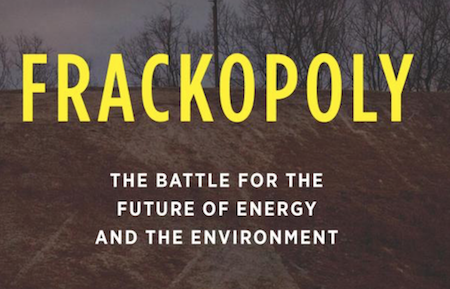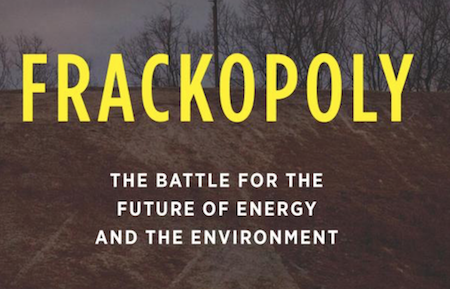by H. Patricia Hynes | ( Truthdig.com) | – –
Frackopoly: The Battle for the Future of Energy and the Environment
A book by Wenonah Hauter (The New Press, 2016)
Branding fracked natural gas as a bridge fuel to renewable energy is one of the great fossil fuel ruses of our times. Two other scams include the trope that “natural gas is safe and green,” and the merchandising of doubt about climate change since the 1970s. Together they are driving us down the path of destruction by fire and water (or lack thereof), with implacable wildfires, drought, deluges, warming seas and sea level rise.
In her latest book, “Frackopoly: The Battle for the Future of Energy and the Environment,” Wenonah Hauter gives readers a bracing critique of the practice, finance schemes and politics of fracking, as well as a thorough, up-to-the minute account of grass-roots mobilizing to oppose fracking, new oil and gas pipelines, and liquid natural gas export terminals. The energy coursing through “Frackopoly” stems from Hauter’s unblinking floodlight on the coddled, corrupt and risk-driven fracking corporations, many of which are the financial progeny of robber barons. It is a fitting companion to Naomi Oreskes’ and Erik Conway’s acclaimed “Merchants of Doubt.” In their exposé, Oreskes and Conway excavated the cover-up of climate change since the 1970s by Exxon and other fossil fuel companies, as well as the perverse Republican campaign to discredit climate change scientists and science, abetted by mainstream media.
In Hauter’s book, the corporate frackers’ exploits are counterpoised with histories of unflinching grass-roots campaigns to leave fossil fuels in the ground, with some remarkable victories. Among these are a detailed case study of the uphill victory to ban fracking in New York state, and an overview from coast to coast of the ban movement, grounded in the environmental and health harms of fracking for oil and gas. As Hauter documents, these harms include immense potable water use even in regions of water scarcity; contaminated aquifers and wells; earthquakes induced by deep injection wastewater disposal; methane leaks at all points of production, transportation, storage and use; and respiratory, neurological and reproductive health impacts on nearby residents. She contrasts the tenacious fracking ban movement in rural communities, on Native American lands and in urban communities of color with the well-heeled mainstream environmental organizations’ concession of “regulating” fracking to lessen spills, methane leaks and drinking water contamination. These blinkered groups — among them the Environmental Defense Fund — play into our government’s national policy of an energy buffet, with renewables providing no more than 20 to 25 percent. The natural gas “bridge” they champion has been tagged a “bridge to nowhere,” a “bridge over a crumbling highway” and “a bridge to climate disaster,” given that new natural gas plants and infrastructure being built for fracked gas have a guaranteed 40-year life span — hardly an interim measure for a renewable future. The world, with an annual average of 22.5 million African, Asian, Pacific Island, and indigenous Alaskan climate refugees, does not have 40 years to spare.
Another rich seam lies in the book’s documentation of the leniency of federal and state regulation on behalf of the oil and gas industry conjoined with the largesse doled out in tax breaks, loopholes and shelters; federal research and development funds; land grants; and investments in ports and inland waterways. Since the 1970s, more than 10 trillion gallons of wastewater from oil and gas drilling have been categorized as non-hazardous and discharged into “class 2” injection wells. According to industry promoters and regulators interviewed by ProPublica, these wells are loosely regulated and receive less scrutiny, so as to protect the oil and gas industry from costly regulation and, thus, help sustain oil and gas production.
Tax policy and subsidies made all early fossil fuel and nuclear energy transitions possible, whereas government support for emerging renewables, including R&D, pale in comparison. Further, the costs from fossil fuel pollution, so-called externalities, which include groundwater pollution from wastewater injection wells, $7.3 trillion spent on patrolling the Persian Gulf oil shipments since the late 1970s, climate change and 7,500 premature deaths each year in the United States, are not borne by the industry. We citizens foot the bill.
What’s especially significant in “Frackopoly” — and rare in much fracking literature — is that the author foregrounds the plague of social harms emanating from “man camps,” code for oil and gas worker settlements. In the small town of Williston, North Dakota, for example, traffic accidents, crime, social disturbances from drunkenness and drug use, and rape have all increased significantly. Since 2000, when the town doubled in size with oil and gas fracking workers, a woman in Williston is more than twice as likely to be raped as in the rest of North Dakota.
With 2.5 million miles of oil and gas pipelines currently crisscrossing the country, east to west, north to south, and 19 pending pipeline projects planned for the whole Appalachian Basin on the East Coast, how can Hauter envisage the hundreds of steadfast actions nationwide to stop new pipelines as a titanic challenge to both the industry and government policy? The answer is perhaps best parsed by Mark Trahant of the Standing Rock Sioux, fighting the construction of the Dakota Access Pipeline, 1,172 miles stretching from Bakken oil fields in North Dakota to oil refineries in Illinois.
Trahant points to the power of social media to mobilize thousands of Native and grass-roots protesters, which by September 2016 included the historic support of 189 Protectors (as those gathered at Standing Rock reservation prefer to be known). They have the moral high ground, he says, in their campaigns to protect their water, ancestral territories and sacred sites. And, further, this is “The Moment” to stop pipelines and keep fossil fuels in the ground. Why now? A rising chorus of investment companies, among them the prominent global stock market index company MSCI, are warning investors to get out of fossil fuels before they become “stranded assets,” due to price volatility and competition from renewables. Portfolios that have divested from fossil fuels over the past five years are outperforming those that haven’t.
Sobering analysis from the Post Carbon Institute, though, counterbalances the “moment is now” surety. For example, “oil is essential to the modern world” because local, national and global transport of goods by heavy trucks, airplanes and container ships (carrying food, raw materials, and manufactured goods, including solar panels and wind turbine parts) rely on oil. These industrial cargo transports have no current energy substitute, unlike cars and trains that can be solar-powered. The revolution in solar and wind energy has focused largely on renewably generated electricity for domestic and commercial light, heat and appliances, while transportation consumes an estimated 30 percent of fossil fuels used in the United States. Transitioning to renewable, non-oil fuels will take two or more decades and has been “woefully insufficient.” We are rapidly running out of time to keep rising temperatures below the critical threshold of 1.5 degrees centigrade. The institute urges that while building a renewable future, we must rapidly transition to local economies, creating resilience and the capacity to produce and transport goods locally and regionally. But the transition to local, renewably powered towns and cities must be a just transition for all if the moral high ground is to be kept. “We have to be mindful that even if we transition to 100 percent renewables,” says Dallas Goldtooth, organizer of the Indigenous Environmental Network, “it doesn’t necessarily mean that society is just, it doesn’t necessarily guarantee that poor communities will have access to basic needs. When we talk about this transition, we have to make sure it’s in line with the principles of social justice and environmental justice.”
As founder and executive director of Food & Water Watch, a watchdog group with offices throughout the United States and the first national organization to support a ban on fracking, Wenonah Hauter writes from a position of expertise on government and corporate accountability as well as on-the-ground activism and advocacy. Reading “Frackopoly” is something of a roller coaster ride — generating visceral disgust with reckless corporate maneuvers and weak, enabling state and federal regulators in tandem with exultation over the grass-roots victories, numbering more than 500, in communities that have passed measures to stop fracking. There is not one expendable sentence in this book. “Frackopoly” should be read side by side with the ominous analysis of the Post Carbon Institute and also Gretchen Bakke’s new book, “The Grid,” in which she contends that the national electrical grid is the “weakest link” in reaching our goal of 100 percent renewable power.
Pat Hynes, a retired professor of Environmental Health from Boston University School of Public Health, directs the Traprock Center for Peace and Justice in western Massachusetts (http://traprock.org). She has opposed nuclear weapons since she visited the Hiroshima Atomic Bomb Museum and Memorial Park in the early 1980s.
Reprinted from Truthdig.com “> Truthdig.com with the author’s permission.
Subscribe to Informed Comment by email and never miss a posting!


 Click to buy
Click to buy 
 © 2025 All Rights Reserved
© 2025 All Rights Reserved